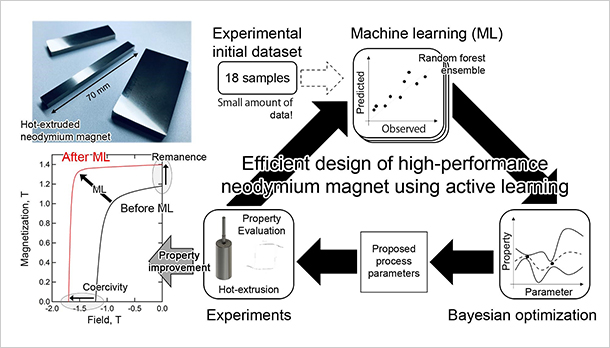Success in Efficient Fabrication of High-Performance Neodymium Magnets Using Machine Learning
— Prediction of optimal processing conditions for neodymium magnets based on limited experimental data—
2021.11.15
National Institute for Materials Science (NIMS)
NIMS has demonstrated that it is possible to maximize the permanent magnetic property of neodymium magnets, for which demand is rapidly increasing as magnets for traction motors in electric vehicles and other applications, with a minimum number of experiments by applying machine learning to experimental datasets obtained by varying the conditions for their fabrication.
Abstract
- The National Institute for Materials Science (NIMS) has demonstrated that it is possible to maximize the permanent magnetic property of neodymium magnets, for which demand is rapidly increasing as magnets for traction motors in electric vehicles and other applications, with a minimum number of experiments by applying machine learning to experimental datasets obtained by varying the conditions for their fabrication.
- As the electrification of a variety of transportation vehicles is being promoted toward the realization of carbon neutral society, neodymium magnets used in motors are also required to satisfy various property requirements depending on the application. Neodymium magnets, the strongest permanent magnet, are fabricated by complicated processes such as sintering or hot-deformation. Since the permanent magnetic property varies greatly depending on the composition of the raw alloy powders and the conditions in the manufacturing process, optimizing countless combinations of the processing conditions is necessary to improve the magnetic property of neodymium magnets.
- The NIMS research team focused on hot-deformed neodymium magnets, which are expected to show better high-temperature properties than conventional sintered magnets. The processing conditions to produce hot-deformed neodymium magnets with excellent permanent magnetic property are predicted through machine learning of the initial dataset on the processing and magnetic properties. Then, the team has demonstrated that the magnetic properties of the hot-deformed magnets can be efficiently maximized when they are fabricated according to the predictions. Using only 18 initial data points, which is usually considered to be too small for machine learning, the permanent magnetic properties have been optimized with only about 40 additional experiments by repeating the property prediction and fabrication experiments using active learning.
- The neodymium magnets will need to meet various property requirements in addition to the magnetic properties, such as mechanical and electrical properties, depending on the application. In order to promptly develop the neodymium magnet with desired magnetic properties, the team will continue to accumulate data on various properties such as alloy composition and magnetic and other properties, in addition to the processing conditions examined in this study, and develop a method that can efficiently predict the fabrication conditions to achieve the required magnetic properties using active learning.
- This work was carried out by a NIMS research team consisting of Guillaume Lambard (Senior Researcher), Taisuke Sasaki (Principal Researcher), Keitaro Sodeyama (Group Leader), Tadakatsu Ohkubo (Deputy Director) and Kazuhiro Hono (Research Fellow).
This work was supported by the Elements Strategy Initiative Center for Magnetic Materials (ESICMM) of MEXT (Grant Number 12016013), through the Ministry of Education, Culture, Sports, Science, and Technology (MEXT). - This research was published online in the Scripta Materialia journal on November 7, 2021 (DOI: https://doi.org/10.1016/j.scriptamat.2021.114341).

Figure. Hot-deformed neodymium magnets (upper left), a graph depicting the improved magnetic properties of magnet samples resulting from active learning assisted by machine learning (lower left), and the active learning pipeline used to optimize fabrication conditions of magnet samples with desirable magnetic properties (right).
Related files
- Research Center for Magnetic and Spintronic Materials
Contact information
(Regarding this research)
-
Guillaume Lambard
Senior Researcher
Energy Materials Design Group,
Research and Services Division of Materials Data and Integrated System
National Institute for Materials Science
Tel: +81-29-860-4848
E-Mail: LAMBARD.Guillaume=nims.go.jp
(Please change "=" to "@")
(General information)
-
Public Relations Office
National Institute for Materials Science
Tel: +81-29-859-2026
Fax: +81-29-859-2017
E-Mail: pressrelease=ml.nims.go.jp
(Please change "=" to "@")
(Regarding this project)
-
Planning Office
Elements Strategy Initiative Center for Magnetic Materials
Research Center for Magnetic and Spintronic Materials
National Institute for Materials Science
Tel: +81-29-859-2634
FAX: +81-29-589-2709
E-Mail: info-esicmm=ml.nims.go.jp
(Please change "=" to "@")
Same Keywords
-
Significant Increase in Power Output of Thermoelectric Materials Using Machine Learning
(machine learning,AI,Bayesian optimization)
2019.03.19
-
Development of a versatile, accurate AI prediction technique even with a small number of experiments
(machine learning,AI)
2021.10.25
-
Accelerating Thin Film Fabrication Processes Using Machine Learning
(AI,Bayesian optimization)
2020.10.21
Recent Press Release
-
Simultaneous Imaging of Intracellular DNA and RNA Using Harmless Light
2025.10.27
-
Development of an AI Device Using Ion Gel and Graphene That Dramatically Streamlines Machine Learning Computations
2025.10.14
-
Demonstrating a Novel Method to Modulate Heat Flow Through the Collective Motion of Spins
2025.10.06
